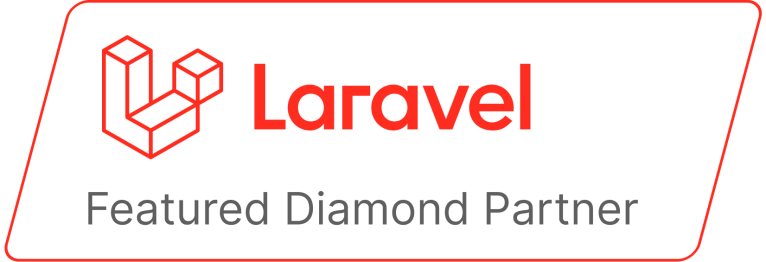Laravel Livewire for Interactive PHP Applications
Build interactive Laravel apps with Livewire—dynamic forms, real-time validation, and reactive interfaces using PHP, minus JavaScript complexity.



👋 Talk to our Laravel team.

Trusted and top rated tech team







Dynamic Laravel development with Livewire
JavaScript frameworks like React and Vue require build pipelines, state management, and API layers between your Laravel backend and frontend. Livewire builds dynamic UIs—real-time validation, interactive tables, auto-saving forms—entirely in PHP and Blade. Your team stays in one language, deploys without build steps, and maintains components with PHP testing tools.
Our capabilities include:
- Interactive component development with Livewire
- Real-time form validation & dynamic UI
- Livewire + Alpine.js integration
- FilamentPHP admin panel development
- Server-side state management
- Performance optimization & caching strategies
Who we support
Laravel teams use Livewire to add interactive features without maintaining separate JavaScript frontends. We work with development teams that need dynamic UIs but want to stay in the PHP ecosystem.

Laravel Teams Building Internal Tools
Building admin panels, dashboards, or internal applications where React/Vue complexity isn't justified. Livewire handles dynamic forms, data tables, and real-time updates without frontend specialists or build pipelines. Your Laravel developers can ship interactive features faster.
Agencies with Multiple Laravel Projects
Managing separate React or Vue frontends across client projects increases complexity and maintenance burden. Livewire keeps logic in Laravel, reducing context switching and making projects easier to maintain when clients need updates or features down the line.
Teams Modernizing Laravel Applications
Laravel apps using jQuery need reactive features without full frontend rewrites. Livewire components add real-time validation, dynamic updates, and interactive UIs. They keep development in PHP, bypassing JavaScript framework complexity.
Ways to engage
We offer a wide range of engagement models to meet our clients’ needs. From hourly consultation to fully managed solutions, our engagement models are designed to be flexible and customizable.
Staff Augmentation
Get access to on-demand product and engineering team talent that gives your company the flexibility to scale up and down as business needs ebb and flow.
Retainer Services
Retainers are perfect for companies that have a fully built product in maintenance mode. We'll give you peace of mind by keeping your software running, secure, and up to date.
Project Engagement
Project-based contracts that can range from small-scale audit and strategy sessions to more intricate replatforming or build from scratch initiatives.
We'll spec out a custom engagement model for you
Invested in creating success and defining new standards

Why choose Curotec for Livewire development?
We build Livewire components that handle complex interactions—multi-step forms, dynamic tables, real-time validation—without requiring your team to learn React or Vue. Our Laravel developers optimize server-side rendering, implement caching strategies, and integrate Alpine.js when client-side interactivity is needed.
1
Extraordinary people, exceptional outcomes
Our outstanding team represents our greatest asset. With business acumen, we translate objectives into solutions. Intellectual agility drives efficient software development problem-solving. Superior communication ensures seamless teamwork integration.
2
Deep technical expertise
We don’t claim to be experts in every framework and language. Instead, we focus on the tech ecosystems in which we excel, selecting engagements that align with our competencies for optimal results. Moreover, we offer pre-developed components and scaffolding to save you time and money.
3
Balancing innovation with practicality
We stay ahead of industry trends and innovations, avoiding the hype of every new technology fad. Focusing on innovations with real commercial potential, we guide you through the ever-changing tech landscape, helping you embrace proven technologies and cutting-edge advancements.
4
Flexibility in our approach
We offer a range of flexible working arrangements to meet your specific needs. Whether you prefer our end-to-end project delivery, embedding our experts within your teams, or consulting and retainer options, we have a solution designed to suit you.
Livewire's versatility across interactive features
Dynamic Form Wizards
Real-Time Search & Filtering
Inline Editing & Auto-Save
File Upload with Preview
Polling & Live Updates
Lazy Loading Components
Tools & technologies for Livewire development
Livewire Component Architecture
We structure components with single-file or class-based approaches, organizing logic and templates for clarity and reusability.
- Class-Based Components – Separate PHP logic in component classes from Blade templates for complex components requiring multiple methods, lifecycle hooks, or heavy business logic.
- Single-File Components (Volt) – Combine PHP and Blade in one file using Volt for simpler components, reducing file switching and keeping related code together during development.
- Component Properties & Data Binding – Define public properties that automatically sync between server and client using wire:model, eliminating manual JavaScript for form field updates and state management.
- Actions & Event Handling – Create public methods that respond to user interactions through wire:click or wire:submit, processing form submissions and button clicks with server-side PHP logic.
- Lifecycle Hooks – Use mount, updated, and rendering hooks to execute code at specific component lifecycle points—initialization, property changes, or before/after rendering.
- Nested Components & Communication – Build complex UIs by nesting Livewire components and using events or direct method calls to communicate between parent and child components for coordinated updates.
Alpine.js for Client-Side Interactions
Curotec integrates Alpine.js for instant UI interactions like dropdown menus, modals, and toggles that respond without server round-trips.
- Dropdown Menus & Popovers – Use Alpine.js for show/hide logic on dropdowns, popovers, and flyout menus that respond instantly to clicks without server requests or page flicker.
- Modal Dialogs & Overlays – Control modal visibility, focus trapping, and backdrop clicks with Alpine, while Livewire handles form submission or data loading inside the modal content.
- Accordion & Tab Interfaces – Manage accordion expansion, tab switching, and collapsible sections with Alpine for instant UI feedback, keeping the current state client-side until server interaction is needed.
- Form Input Enhancements – Add character counters, password visibility toggles, and input masking with Alpine.js, enhancing form usability without adding server overhead for purely presentational features.
- Transitions & Animations – Implement smooth fade-ins, slide transitions, and micro-animations using Alpine’s x-transition directives, making interface changes feel polished without custom CSS animations.
- Client-Side State Management – Store temporary UI state like sidebar visibility, selected filters, or active sections in Alpine, preventing unnecessary Livewire component re-renders for UI-only changes.
FilamentPHP for Admin Interfaces
Our team builds admin and management interfaces with FilamentPHP, leveraging its pre-built components for rapid development.
- Resource Management Panels – Generate CRUD interfaces for database models with automatic table views, forms, and validation rules—FilamentPHP handles listing, creating, editing, and deleting records with minimal code.
- Form Builder Components – Use Filament’s pre-built form fields—text inputs, file uploads, rich text editors, relationship selectors—that handle validation, data binding, and complex field interactions out of the box.
- Advanced Data Tables – Build sortable, filterable, searchable tables with bulk actions, column customization, and export functionality using Filament’s table builder without writing custom query logic.
- Dashboard Widgets & Stats – Create admin dashboards with stat cards, charts, and data widgets that pull metrics from your database, displaying key performance indicators and real-time business data.
- Role-Based Access Control – Implement permission systems that control which users can view, create, edit, or delete specific resources, integrating with Laravel’s authorization policies and gates.
- Custom Actions & Bulk Operations – Add custom buttons and bulk operations to resource tables—approve records, send notifications, export data—triggering server-side logic with visual feedback and confirmation dialogs.
Laravel Reverb for Real-Time Features
We implement Laravel Reverb to broadcast events for real-time notifications, live chat, and multi-user collaboration.
- Real-Time Notifications – Broadcast events when server-side actions complete—order confirmations, payment processing, job completions—so users see instant updates without polling or refreshing the page.
- Live Chat & Messaging – Build chat interfaces where messages appear immediately for all participants, with typing indicators and read receipts that sync across multiple browser tabs and devices.
- Collaborative Editing – Show when multiple users edit the same record simultaneously, displaying active users, lock indicators, or real-time field updates to prevent conflicting changes.
- Dashboard Data Streaming – Push live updates to dashboards when metrics change—new orders, system alerts, inventory levels—keeping all connected users synchronized without manual refresh intervals.
- Event Broadcasting to Specific Users – Target broadcasts to individual users, user groups, or channels based on permissions, ensuring sensitive notifications reach only authorized recipients.
- Presence Channels & User Status – Track which users are currently active in the application, showing online status, active sessions, or who’s viewing specific pages for collaborative workflows.
Caching & Performance Optimization
Our engineers implement query caching, lazy loading, and component memoization to reduce server load while keeping Livewire responsive.
- Query Caching & Database Optimization – Cache expensive database queries that power dropdown options, filter lists, or dashboard metrics, reducing query execution time and database load on repeated component renders.
- Component Lazy Loading – Defer rendering of data-heavy components until they’re visible on screen, showing placeholders initially and loading content in the background to improve initial page load times.
- Computed Property Memoization – Cache computed property results within component lifecycles so expensive calculations run once per render cycle instead of recalculating on every property access.
- Debouncing User Input – Delay server requests triggered by user typing in search fields or filters using wire:model.debounce, reducing unnecessary server round-trips while users are still entering text.
- Response Caching with wire:offline – Store component responses in browser cache so users can interact with previously loaded components during network interruptions or while offline, improving perceived performance.
- Asset Optimization & Bundling – Minimize Livewire’s JavaScript footprint, implement lazy loading for Alpine.js, and use Laravel Mix or Vite to bundle and compress assets for faster page loads.
Testing Livewire Components
We write PHPUnit tests for Livewire components, validating user interactions, state changes, and server-side logic with Laravel’s tools.
- Component Interaction Testing – Test user interactions like button clicks, form submissions, and input changes using Livewire’s test helpers to simulate wire:click and wire:model behavior in PHPUnit tests.
- State Assertion & Property Validation – Verify component properties update correctly after user actions, asserting that public properties reflect expected values and component state changes propagate as intended.
- DOM & View Assertions – Assert that component renders display correct HTML, show/hide elements based on state, and update dynamically when properties change during test execution.
- Event Emission & Listening Tests – Test that components emit events correctly and respond to events from other components or parent elements, validating inter-component communication patterns.
- Validation Rule Testing – Verify form validation rules trigger appropriately, error messages display correctly, and invalid input prevents server-side processing as expected in component logic.
- File Upload Testing – Test file upload components using Laravel’s fake storage, asserting that uploaded files are processed, validated, and stored correctly with proper error handling for invalid files.
FAQs about Laravel Livewire development

When should we use Livewire instead of React or Vue?
Livewire works well for Laravel teams building admin panels, dashboards, or business applications where your developers know PHP better than JavaScript frameworks. Choose React or Vue for SPAs requiring offline functionality, complex client-side state, or apps where most logic runs in the browser without server interaction.
Is Livewire as fast as React or Vue?
Livewire makes more server requests than React or Vue because it renders on the server. For most business apps with moderate traffic, the difference is imperceptible. However, performance-heavy interfaces like real-time collaboration tools or complex animations benefit from client-side frameworks that avoid round-trips for every state change.
Can we use Livewire with existing Laravel applications?
Yes, Livewire components integrate into Blade templates without requiring changes to your app’s architecture. You can add Livewire gradually—replacing one jQuery form or table at a time—while the rest of your app works as usual. No need to rewrite your entire frontend.
Do we need JavaScript knowledge to use Livewire?
While basic JavaScript knowledge is helpful, it isn’t required for most Livewire development. Complex interactions might need Alpine.js, and you may write small JavaScript snippets to integrate third-party libraries, but Livewire’s core functionality uses only PHP and Blade templates.
How do we test Livewire components?
Livewire components use PHPUnit tests in Laravel’s framework. You can simulate user actions, check property changes, verify output, and test validation rules using Livewire’s test helpers—all in PHP without needing browser automation or JavaScript tools.
Can Livewire handle real-time features?
Yes, through Laravel Reverb or Pusher. Livewire works with WebSocket broadcasting for real-time notifications, chat, dashboards, and collaborative features. The server broadcasts events, and Livewire components automatically update for all connected users.
Ready to have a conversation?
We’re here to discuss how we can partner, sharing our knowledge and experience for your product development needs. Get started driving your business forward.